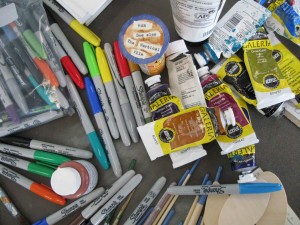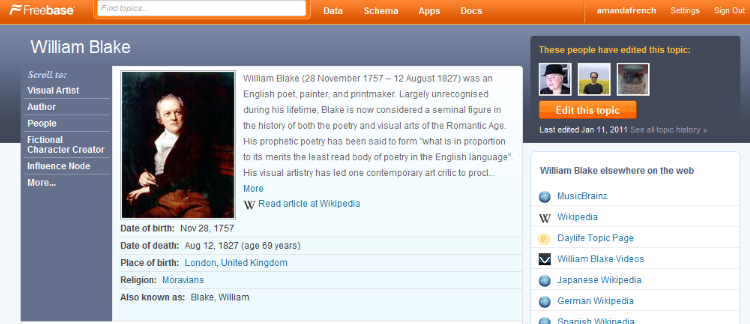
art supplies at THATCamp Craft Cabin
It may seem out of place to offer a table full of art supplies at a digital humanities gathering. Painting and collaging, are, after all, quite firmly analog activities (thus the messy hands, and at least one staple injury). So what was the deal with the Craft Cabin at THATCamp SoCal?
Part of the thinking was that it would be “unconferency,” in a good way that mirrors the best of digital humanities gatherings. Craft Cabin would also be an informal, creative, participatory space, where everyone gets a chance to create new things onsite. The specific materials provided (old books, card catalog cards, historical images, rubber stamps of words and postal marks) were chosen because they offered “texts” to remix and, in the process, discuss. We also hoped Craft Cabin would be a challenging experience of new tools and unfamiliar processes for some–much as the digital environment challenges many newcomers. Remembering the “where do I start? what do I do? what will happen if I try this?” stage of learning can be valuable.
We didn’t really know what would happen at the Craft Cabin–it was an experiment. But here’s some of what did happen:
1. During registration, folks drifted over and started embellishing their nametags with ink, collage, rubber stamps, and sharpies. By the time the first session started, several THATCamp participants were already wearing a personalized ID.
2. A shoebox full of old card catalog cards drew curious visitors to the table, to sort through and share their best finds. Some of those cards were cut up, and the choicest phrases found their way onto wooden pins, collages, and nametags. (What else can you do with old card catalog cards? The Brooklyn Museum is currently asking that question!)
3. Participants worked on projects between sessions, which left time for their work to dry between steps. It was fun to watch the collages develop over the course of the meeting.
4. A printer was onhand, so participants could print images or sentences or names to add to their works, and quite a few did. But for others, there were pre-printed images (most of them from Flickr Commons), sheet music, and academic journals to cut out.
5. Modpodge happened. A lot. It even featured in the lyrics of a song about Craft Cabin, composed and performed by one of the THATCampers. (Still hoping to see those lyrics on the blog as promised.)
If someone else ever wants to try a Craft Cabin activity, these are the supplies that seemed to be most useful at ours. Almost all of it is easy to find at a general craft store. Get plenty: people are often more willing to use supplies if they can see that there’s no shortage.
- canvasboards
- sharpies
- acrylic paints
- inkpads and walnut ink
- rubberstamps
- wooden shapes to use in making pins
- pinbacks
- stuff to cut up: music, images, texts, ephemera
- jumprings
- brushes
- xacto knives
- stencils
- cardboard
- paper towels
- modpodge
- tape
- paper punches and die-cuts in different shapes
- ribbon
It might also be nice to bring interesting papers and cardstocks, brads, a stapler, colored pencils, zip bags, maps. I’d say it’s worth having someone onsite whose primary responsibility is the Craft Cabin. That person can still attend sessions (I did!), but they’d be available to help folks at other times, keep track of supplies, etc. And I think the location of the Craft Cabin was also ideal at the SoCal event: we were right off the main meeting room, separate but visible–and near the coffee and snacks, which is always an advantage.



